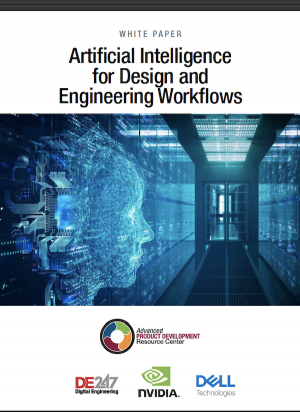OzenCon Keynotes Highlight AI-Powered Simulation, Digital Twins, More
Conference examines the role of AI in future product development.

Ansys CTO Prith Banerjee discusses the integration of hardware, software, and electronics in future products. Photo by Kenneth Wong, DE 24/7.
Engineering Resource Center News
Engineering Resource Center Resources


Dell

Latest News
March 8, 2024
OzenCon, the simulation user conference hosted by Ansys reseller Ozen Engineering Inc., took place at the Computer History Museum (Mountain View, California) on February 22. Dr. Prith Banerjee, CTO of Ansys, joined the conference as the keynote speaker. His talk entitled “The Future of Digital Engineering,” acknowledged that while the use of simulation and test to develop products had been the norm for the past 50 years or so, a sea change was rapidly approaching, according to him.
“Digital engineering is how you engineer future products, which include hardware, mechanical and electronics parts, as well as software. Typically, these things are done in a siloed way, with different teams doing different things … Ansys is preparing engineers to use requirements, written in languages like SysML, to use a system architecture modeling tool called SAM, and to connect that with our accurate 3D solvers like Ansys Mechanical, LS-DYNA, Ansys Fluent, and so on,” said Banerjee.
Merging ECAD and MCAD
The silos between electrical and mechanical are evaporating, due in large part to partnerships between ECAD and MCAD vendors, as well as from industry consolidation. In January, Synopsys signed a deal to acquire Ansys for $35 billion. Reuters reported, “The transaction will create a massive new player in a sector of the business software industry that is already highly consolidated … The deal would bring together Synopsys' semiconductor electronic design automation (EDA) tools with Ansys' simulation and analysis portfolio.”
A few weeks before OzenCon, at the 3DEXPERIENCE World event in Las Vegas, Synopsys’s rival Cadence announced a partnership with popular CAD software maker SOLIDWORKS to bring their solutions together. These acquisitions and partnerships foretell future corporate handshakes that will bring chip design and mechanical design closer than ever.
Ansys is also injecting AI into its simulation tools, aiming to make them run faster and become easier to use. “We just announced a tool earlier this year called Ansys SimAI, which lets you take any of our black-box solvers and train an AI model. Once trained, it will run simulation hundreds of times faster,” said Banerjee.

Different Twins for Different Needs
Teresa Alberts, CEO of ITficient, was another keynote speaker at OzenCon. Her talk was titled, “Applications and Benefits of Digital Twin for the Manufacturing Industry.” Alberts said, “Where the digital twin brings value depends on the product and what the customer’s pain points are. If they can identify the pain points, then the digital twin can help address them, and bring added value.”
Alberts highlighted the case of several power plant operators in her presentation. “They use digital twins to ensure the plants’ availability, to see the condition of the critical components, to get forecasts about the remaining lifetimes of the critical components, and to service them in advance.”
For digital twin owners and operators, the amount of data collected from sensors would be a significant data analysis burden. Ansys anticipates its tool can fill a need. “By integrating AI-based data analytics with simulation, you can create what we call hybrid digital twins.”
AI-Ready Hardware
Many of the AI workloads, such as using machine learning to perform data analysis or object recognition, are expected to drive up the demand for computing power, often beyond what’s normally available in a personal workstation. Most likely, engineering simulation in the future will require a mix of on-premise hardware and on-demand computing.
This month, Dell announced the new Dell Precision 3680 desktop tower, the latest workstation targeting CAD users. It can be configured with the full range of NVIDIA professional GPUs, including NVIDIA’s newly released RTX 2000 Ada GPU, based on the NVIDIA Ada Lovelace GPU architecture, featuring 16GB of high performance GPU memory.
Manufacturing workflows typically include design and simulation for virtual prototyping that require desktop workstations with GPUs for quick and realistic visualization of intricate geometries and for rapid computations.
Zihan Wang, High-Tech Strategy and Operations manager for NVIDIA, said, “If you want to simulate the motion of granular materials in the mining industry, like particles on a conveyor belt in a mixer, double-precision GPUs are required to speed up the simulation. We have the NVIDIA RTX A800 40GB Active GPU for that type of simulation. It’s a workstation GPU so you can embed it into your Dell Precision workstation … For simulations where single precision provides the required accuracy, NVIDIA RTX Ada Generation GPUs will provide incredible performance.”
As AI speeds up processing, Wang expects engineers to expand the use of simulation. “With AI-embedded HPC, you can process more data points to make a better decision,” he said.
More Dell Coverage

More NVIDIA Coverage
Subscribe to our FREE magazine, FREE email newsletters or both!
Latest News





